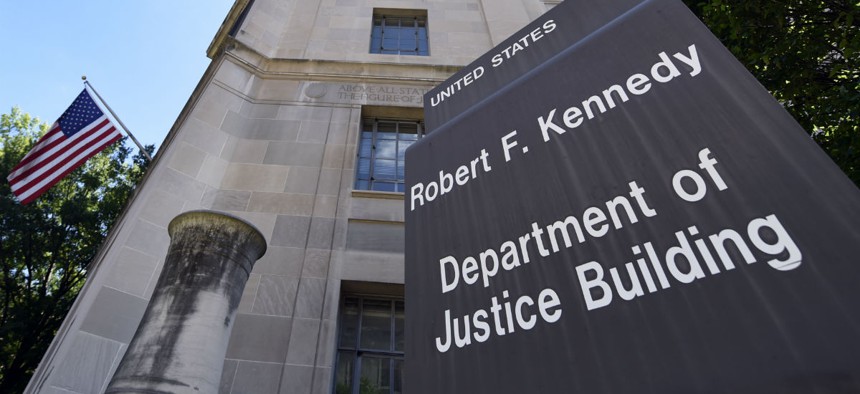Justice, DHS Probe Hack Allegedly Made Possible By DOJ Help Desk

AP Photo/Susan Walsh The view of the Justice Department in Washington, Thursday, Aug. 27, 2015.
A hacktivist claims a help desk aided his intrusion into a computer containing contact information on some 9,000 DHS personnel and 20,000 FBI employees.
The departments of Justice and Homeland Security are investigating a Justice hack allegedly made possible by the enemy of secure logins -- IT support.
Many federal agencies, including Justice, recently switched on two-factor authentication intended to stop hackers from busting into government databases with merely a password. But that second factor for identification isn't all that safe, when it only takes a call to the help desk for a second form of authorization, say security experts.
Now, a hacktivist, who wishes to remain nameless, claims that technique is exactly what he used to break into a computer containing contact information on some 9,000 DHS personnel and 20,000 FBI employees.
The hacker already had a password for a Justice employee's email account, according to Motherboard, which first reported the breach Feb. 7. From the account, he attempted to log into a restricted department website. When he couldn't enter, he dialed the relevant help desk.
“So I called up, told them I was new and I didn't understand how to get past [the portal],” the hacker told Motherboard. “They asked if I had a token code, I said no, they said that's fine—just use our one.”
A former FBI official said there are existing policies that prohibit Justice IT support personnel from supplying a token without further verifying the individual requesting access is who he or she claims to be.
The individual typically must either visit a facility -- in person -- that can identity-proof the employee, or he must prove his identity over the phone by providing knowledge only he would know.
"I'm not sure it was in the protocol for the help desk to provide the token for access without significant further authentication," Leo Taddeo, former FBI special agent in charge of the special operations and cyber division, told Nextgov. "Probably, if you trace it back, it is a failure to follow proper protocol. It's probably someone just wanted to be helpful."
Technology and policy safeguards fail when confronted by human nature, he said.
"The weakest point is the user," said Taddeo, now chief security officer for cyber firm Cryptzone. "It's the human being, no matter what we design, no matter how much we emphasize the technological solutions -- if we have users and especially help desks and system administrators that circumvent technology controls by just giving away information."
White House Requests $26 Million for Justice Cybersecurity
On Tuesday, Justice officials declined to comment on IT support procedures for users locked out of department accounts. But they acknowledged a probe into a breach is underway.
"The department is looking into the unauthorized access of a system operated by one of its components containing employee contact information," Justice spokesman Peter Carr said in an emailed statement. "There is no indication at this time that there is any breach of sensitive personally identifiable information."
He added that the department will continue "to deploy protection and defensive measures to safeguard information."
DHS spokesman S.Y. Lee said Homeland Security takes such allegations very seriously.
"We are looking into the reports of purported disclosure of DHS employee contact information," he said, adding, "however, there is no indication at this time that there is any breach of sensitive or personally identifiable information."
After revelations Office of Personnel Management hackers stole a gigantic number of national security employee records, the White House in June 2015 ordered all agencies to accelerate the activation of two-factor authentication.
As of last October, more than 80 percent of civilian employees governmentwide needed a password plus a smartcard, digital token or other secondary ID format to enter agency systems.
The Obama administration’s budget proposal for 2017, released Tuesday, requests $26 million from Congress for the "Justice Security Operations Center; for the Identity, Credentialing, and Access Management program; to enhance information security and continuous monitoring; and for a stronger insider threat program."
Whoever is behind the leak of FBI and DHS contacts tweeted links to the data accompanied by Pro-Palestine messages, using the handle @DotGovs.
The stash included DHS employee names, official titles, departments, phone and fax numbers, state and country address information, and official DHS.gov email address, according to Reuters and researchers at the SITE Intelligence Group.
‘This Is a Continuing Threat’
During a Monday call with reporters about the budget, White House cyber czar Michael Daniel said, "With the breach today -- at DOJ" what that "shows is that this is a continuing threat of varying degrees. We’re still sort of understanding better exactly what happened there.”
The dump of Rolodex information does not seem to come close to the severity of the OPM data theft.
"It doesn't sound like he got into a sensitive database," Taddeo said. "It sounds like he got into an address book that would accompany an email account."
Similar recent social engineering hacks reportedly deceived Verizon and Amazon customer support representatives.
Last fall, a member of the hacktivist group “Crackas with Attitude” impersonated a Verizon technician over the phone to gain data necessary for accessing CIA Chief John Brennan's AOL account. The hacker provided a real Verizon worker a fake employee code and then asked for the details about Brennan.
Software developer Eric Springer last month wrote on Medium about an ID thief who, he said, supplied an Amazon customer service rep an incorrect mailing address found online at whois.com, to similar effect.
“Wow. Just wow. The attacker gave Amazon my fake details from a whois query, and got my real address and phone number in exchange. Now they had enough to bounce around a few services, even convincing my bank to issue them a new copy of my credit card,” Springer wrote.



